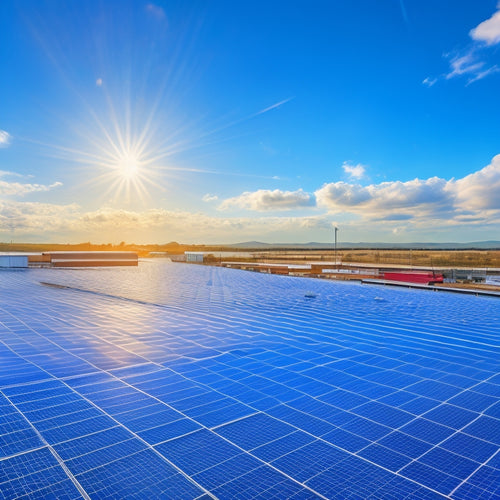
What Is a Portable Power Inverter System?
Share
You're looking for a reliable way to power your devices off the grid, and that's where a portable power inverter system comes in. This system converts DC power from sources like solar panels or wind turbines to AC power, allowing you to use your devices anywhere. A key benefit is its compact design, making it easy to integrate into vehicles or backpacks. It's also adaptable, giving you control over your energy needs in various situations. With a portable power inverter system, you'll enjoy energy independence and comfort - and examining its components, benefits, and considerations will help you make the most of this technology.
Overview
- A portable power inverter system converts DC power from sources like solar panels or batteries to AC power for devices.
- It features a compact design, allowing for easy transport and integration into vehicles or backpacks.
- The system includes a high-capacity battery, efficient inverter, high-performance charging system, monitoring system, and safety features.
- Portable power inverter systems provide energy independence and flexibility for off-grid applications, enabling productivity and comfort.
- Proper installation, maintenance, and safety precautions are essential for reliable operation and preventing electrical shock hazards and overheating risks.
Defining a Portable Power Inverter
A portable power inverter system's core component is the inverter itself, a device that converts DC power from a battery or other source into AC power, mimicking the alternating current supplied by the grid.
You have several inverter types to choose from, including pure sine wave, modified sine wave, and square wave, each suited for specific usage scenarios. For instance, if you need to power sensitive electronics like laptops or medical equipment, a pure sine wave inverter is your best bet.
When selecting an inverter, it's vital to take into account energy requirements and sizing to guarantee the system can handle your energy needs. Modified sine wave inverters, on the other hand, are suitable for general-purpose appliances like lights, fans, and TVs.
Understanding the different inverter types and their usage scenarios is critical in selecting the right portable power inverter system for your off-grid excursions.
How It Differs From Other Inverters
You'll find that a portable power inverter system stands out from other inverters due to its power source flexibility, allowing you to connect to various energy sources.
With the increasing popularity of renewable energy solutions among homeowners DIY solar projects, this system's adaptability is particularly useful for those who want to utilize energy from different sources.
Its compact design also provides a significant advantage, making it ideal for applications where space is limited.
Unlike traditional inverters, this system's unique combination of flexibility and compactness sets it apart from the rest.
Power Source Flexibility
Plug into versatility with the portable power inverter system, which breaks free from the constraints of traditional inverters by offering unparalleled power source flexibility.
You're no longer tied to a single power source, as this system can seamlessly switch between different energy sources, ensuring you have power when and where you need it.
Whether you're setting out on outdoor excursions or seeking energy independence, this system enables you to generate power from various sources, including solar panels, wind turbines, or fossil fuels.
With high-capacity solar chargers supporting large battery banks, you can recharge rapidly and efficiently, making it ideal for off-grid applications or emergency power backup systems.
This flexibility means you can adapt to changing circumstances, making it ideal for off-grid applications or emergency power backup systems.
With the portable power inverter system, you're in control of your energy needs, whenever and wherever you need it.
Compact Design Advantage
The portable power inverter system's compact design packs a punch, boasting a markedly smaller footprint than traditional inverters, making it a revolutionary advancement for mobile and off-grid applications.
You'll appreciate the system's lightweight materials, which enable effortless transport and deployment. This compact design advantage translates to increased travel convenience, as you can easily stow the system in your vehicle or backpack.
Unlike bulky traditional inverters, this system won't weigh you down or occupy essential space. Its sleek, compact profile allows for seamless integration into your mobile lifestyle, giving you the freedom to venture off the grid without sacrificing power reliability.
Key Components of the System
Within the portable power inverter system, several critical components work in tandem to facilitate efficient power conversion and distribution.
You'll find a high-capacity battery with advanced battery compatibility, guaranteeing seamless integration with various battery types.
The system's inverter is designed for maximum inverter efficiency, converting DC power to AC with minimal energy loss.
A high-performance charging system rapidly replenishes the battery, while a sophisticated monitoring system tracks performance and alerts you to any issues.
Additionally, built-in safety features, such as overcharge protection and short-circuit prevention, safeguard your equipment and guarantee reliable operation.
Benefits for Off-Grid Energy Users
Opting for off-grid energy solutions often means contending with limitations and uncertainties.
However, with a portable power inverter system, you can overcome these challenges and achieve energy independence.
You'll have the freedom to power your devices and appliances wherever you go, whether it's for outdoor excursions or remote living.
This means you can stay connected, productive, and comfortable, even when you're far from the grid.
A portable power inverter system also gives you the flexibility to choose your energy source, such as solar or wind power, and convert it into usable electricity.
This level of autonomy and flexibility is essential for those who crave freedom and self-sufficiency.
Choosing the Right Inverter Size
You've achieved energy independence with your portable power inverter system, and now it's time to confirm you're getting the most out of it.
Choosing the right inverter size is vital to maximize energy efficiency and avoid wasting power. Calculate your total power requirements by adding up the wattage of all devices you'll be running simultaneously.
Consider the inverter's continuous and surge wattage ratings to ascertain it can handle your power needs. A correctly sized inverter will optimize energy efficiency, reducing energy waste and prolonging your system's lifespan.
Don't undersize or oversize your inverter – it's important to get it just right. By doing so, you'll enjoy reliable, efficient power wherever you go, whenever you need it.
Safety Precautions and Considerations
When you're working with a portable power inverter system, you're dealing with electrical currents that can be hazardous if not handled properly.
You need to be aware of electrical shock hazards, overheating risks, and the importance of proper installation to avoid accidents.
Electrical Shock Hazards
Electrical shock hazards pose a significant threat to users of portable power inverter systems, particularly when they aren't installed, operated, or maintained correctly.
You must take shock prevention measures seriously to avoid accidents. Confirm your system is installed and operated by a qualified electrician who understands circuit protection principles. Always follow the manufacturer's instructions and guidelines for safe operation.
Keep the system clean and dry, and avoid overloading it. Regularly inspect the system for signs of wear and tear, and perform maintenance tasks as recommended.
Overheating Risks Exist
Its high-power components and compact design make your portable power inverter system prone to overheating, a risk that can be mitigated with proper precautions.
Overheating causes include inadequate airflow, high ambient temperatures, and excessive power draw. These can lead to reduced system performance, premature component failure, and even fires.
To minimize the risk, guarantee good airflow around your system, keep it away from heat sources, and avoid overloading. You can also consider cooling solutions like fans or heat sinks to dissipate heat more efficiently.
Proper Installation Matters
Installing your portable power inverter system correctly is essential to guaranteeing safe and reliable operation. You must follow proper installation tips to avoid electrical shock, fire hazards, and equipment damage.
When choosing an inverter placement, consider the ambient temperature, humidity, and airflow. Ascertain the inverter is installed in a well-ventilated area, away from flammable materials and moisture.
Secure the inverter firmly to prevent vibration and movement. Properly connect the cables, observing polarity and voltage ratings.
Finally, test the system to confirm it's functioning correctly. Remember, a poorly installed system can lead to serious consequences, so take the time to get it right.
Frequently Asked Questions
Can a Portable Power Inverter System Be Used for Emergency Backup Power?
You can rely on a portable power inverter system for emergency backup power, ensuring power reliability by selecting an inverter capacity that matches your essential load requirements, giving you freedom from grid dependence during outages.
Are Portable Power Inverters Compatible With All Types of Appliances?
When you're off-grid, think of your portable power inverter as a matchmaker - it needs to find the perfect appliance partner. Not all are compatible, so check the inverter wattage and guarantee it matches your appliance's needs for a harmonious power connection.
Do Portable Power Inverters Have Built-In Surge Protection?
You'll find that many portable power inverters come equipped with built-in surge protection, safeguarding your devices from voltage spikes, while also ensuring peak inverter efficiency, giving you the freedom to power up anywhere, anytime.
Can I Use a Portable Power Inverter in an RV or Boat?
As you cruise down the highway in your RV or sail across the open waters in your boat, you're wondering if a portable power inverter can keep up with your journeys; yes, it can, with compatible RV power connections and optimized Boat energy efficiency.
Are Portable Power Inverters Suitable for Powering Medical Equipment?
When powering medical equipment, you'll want to guarantee the portable inverter's power rating matches the device's wattage, and verify medical device compatibility to prevent damage or malfunction, as some devices require a pure sine wave output.
Ready to Buy
You now possess an extensive understanding of portable power inverter systems, allowing you to utilize the power of off-grid energy with confidence. Curiously, according to the US Energy Information Administration, in 2020, renewable energy accounted for 21% of the world's electricity generation, up from 11% in 2009, highlighting the growing demand for reliable, portable power solutions. With this knowledge, you're enabled to choose the right inverter size and enjoy the benefits of off-grid energy independence.
Related Posts
-

Solar Phone Chargers for Camping Essentials
Solar phone chargers are must-haves for your camping essentials, allowing you to stay connected while enjoying nature...
-

How Efficient Are Thin Film Solar Cells
Thin film solar cells provide an innovative approach to energy generation, boasting efficiency rates generally betwee...
-

Commercial Solar Energy
As you consider powering your business with commercial solar energy, you'll uncover it offers a triple benefit: signi...


